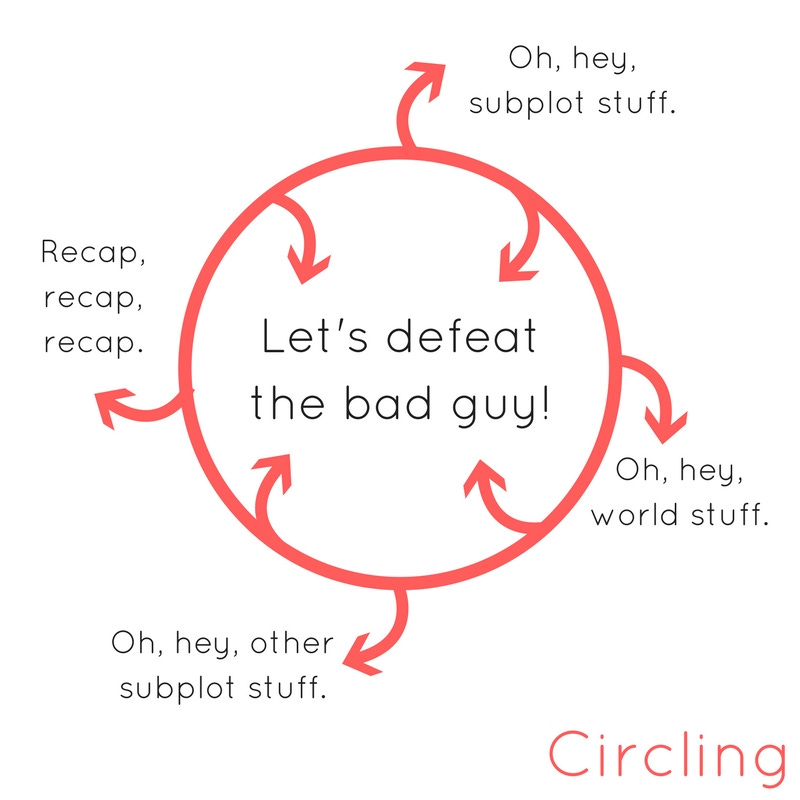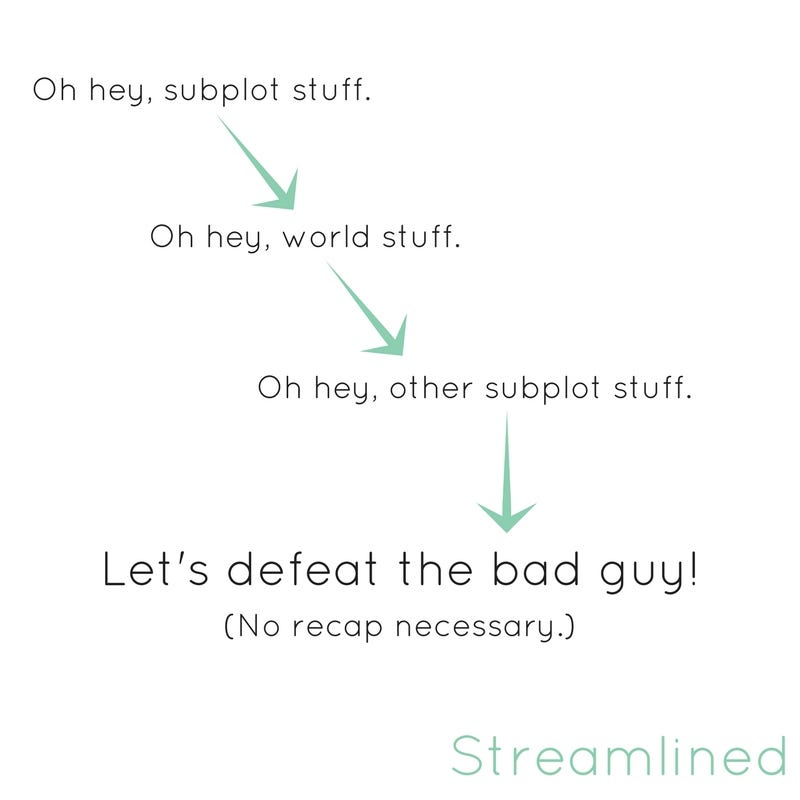Tightening Your Prose: Part 1
Eliminating redundancies & closing scene "circles"
@Katie Higgins asked:
Hi Sooz! I'd love to know if you have any tips on making significant cuts? I'm working on a draft to query and as a YA fantasy I need to get it under 100k and it's currently sitting at 110k (at draft 3). Is there anything you ask yourself when trying to cut/combine? 10k to cut sometimes seems like not that much, and then other times it seems impossible!
AH! Katie! You have asked me about one of my favorite parts of revision: the tightening phase.
I think I have mentioned before that I’m a puzzle solver1 and my favorite video games are immersive sims for this very reason: I can play and replay a game until I find the best way through a mission. Ah, it is so satisfying!
And so is tightening a scene for me. What is the best way to share all the information and emotion and action in this part of the story?
I actually wrote about this exact subject six years ago in a newsletter, but rather than reinvent the wheel, I’ll be taking that old post and updating it for you here.2 It’s also a lot of information, so I’m splitting it in two posts for easier consumption.
I also want to mention that I have tightened so many books at this point in my career (without cutting anything hugely meaty) that I am essentially a pro at it.
I tightened Bloodwitch from 160,000 words to 145,000 words.
I tightened Witchshadow from a 180,000 words to 168,000 words.
And I actually tightened Truthwitch from 160,000 words to 120,000! But I also cut a subplot from the second act in that book, which contributed to the massive drop in word count.
This really is one of my favorite parts of the process, and friends have turned to me before to create “paint by numbers” critiques for them that show them exactly where to cut, combine, and condense.
So how, Sooz? HOW DO YOU DO IT? Give us your wisdom and secrets!
Well, there are 4 primary ways in which I tighten my manuscripts:
I eliminate redundancies.
I close my scene “circles.”
I remove filler actions.
I cut excess action tags.
Now, before I dive in, I do want to mention that I don’t follow these steps while drafting. These are steps I take during revisions—specifically later revisions.
In other words, I need the story to be solidly hammered out before I go through and tighten my words. I want to be finished with my “macro” revisions such as rearranging plot points, adding new scenes, cutting scenes, changing character arcs, etc. Because if I am going to be majorly gutting a scene, why bother fine-tuning the prose and tightening it? The whole scene might all get cut or rewritten anyway!
So now that we’ve established when I tighten, let’s get started, shall we?
Eliminating Redundancies
One of the key ways that I can cut a LOT of words is by eliminating redundancies.
Redundancies can crop in all sorts of ways. Perhaps you mention forty-seven times that a character has gray eyes. Do we really need that reminder every time we see him?3
These are obvious repeats that you can quickly weed out.
Other redundancies are more subtle—these are your emotional repeats. "Beats" we call them, and our characters hit many beats throughout the course of a book or series. What we don't want, however, is for a character to hit the same beats again...and again...and again and again.
An example: Let’s say you have a character who gets betrayed by their best friend. The story develops for a while, and we see the emotional fallout.
Then they get betrayed again! By their boyfriend!
Erm, wait…didn’t we already do this once? If the character reacts differently to the second betrayal and it’s part of the growth, then okay! But if it’s the same emotional fallout from the same sort of plot point…
Ruh-roh. That won’t do! It’s time to cut one of these redundant beats!
Closing Your Scene “Circles”
Similar to eliminating redundancies, we have what I call closing your scene “circles.”
Circling—a concept that perhaps has another name, but since I've never heard anyone talk about it, I call it circling 😂—is when a scene meanders from Point A to Point B...then back to Point A before stopping at Point C and finally ending at Point B.
You see this frequently with dialogue. Characters are talking about Defeating The Big Bad. Then they hop over to discuss another subplot. Then they move back to Defeating The Big Bad (and end up recapping a bit in order to reorient the reader)…
Then, oh yeah, let's talk about the world's history a bit. Now let's go back to Defeating The Big Bad (with a bit more recap).
And what about THIS subplot—but oh wait, we still gotta deal with the Big Bad!
Rather than circle around and around, we could just organize the scene's dialogue to hit Defeating the Big Bad only once.
In other words: the characters could start by talking about one subplot and its connection to the world history, then they move to that other subplot, and THEN they move to Defeating the Big Bad.
Bam, bam, bam!
Honestly, this is SUCH an easy mistake to make, and it’s one I make in basically every scene during a first draft.
I’m drafting along, not sure where a scene is going, so I wander over here...then over there...then back to here...then, oh! Okay, now I see what the point of all of this was to begin with. So then I wrap up the scene and end it.
Because of my meandering, I also often end up with redundant emotional beats too! They’re angry at the Big Bad, then they get distracted by X plot and that has it’s own emotions…now it’s back to the anger! Then the Y plot emotions…then more anger!
Fortunately, this also an easy mistake to fix.
Once I know that things are circling, all I have to do is figure out a more direct way to offer the information. Then I can rearrange my scene so that everything moves in a logical, streamlined direction and no beat or conversation point gets hit more than once.
Also, here’s another way I avoid this in the planning, pre-writing stage!
I should also mention, that on a macro level, circling can creep in with settings.
So for example: I remember back when I wrote Something Strange & Deadly, I had my main characters return to the Spirit-Hunters' lab between almost every plot point...and then had my protagonist Eleanor return to her house.
Literally, we circled from new location to old location to old location…to new to old to old. It was so redundant, it slowed down the story, and it didn't add anything new to the plot.
My solution? Condense and combine! I took all those scenes in the Spirit-Hunters’ lab and combined them into just a handful of scenes. then I did the same thing with all the scenes at Eleanor's house.
I mean, why have her mother talk to her about a handsome suitor in six different scenes, especially since she only input a little bit of new plot during each exchange? I could make it two scenes instead and help the pacing move much faster—not to mention, it would help cut down on words!
That’s part 1 for you, Katie, and I hope it helps! Next time, I’ll dive into the other two techniques I use for tightening: removing filler actions + cutting excess action tags.
These are actually quite similar approaches (which is why I’m lumping them together), and by addressing those pesky “actions,” I can REALLY cut a lot of words.
Thanks for the question, Katie!! And thank you so much for being a paid subscriber.
💚 - Sooz
It’s that #2 Restorative, for those of you who also know Clifton Strengths!
Lol, what is the best way to teach you this information?
Sometimes you DO! I definitely reiterate repeatedly in The Luminaries that Jay has gray eyes. There’s a reason for that, though, and it’s all about setting up the VIBES of that book and setting and world—as well as who he is as a person.




CLIFTON STRENGTHS!
Ahem. I was just writing on them for a paper, so I got a little excited.
Love this newsletter! This arrived right when I needed it. I'm currently removing "Repeats" and I was getting frustrated but this makes me feel so much better! I can fix it 😊 Thanks Sooz xx